With Chinese New Year rapidly approaching, this is a good time to read Chinese folktales with your kids. This list is part of our continuing book list series featuring global folktales. I know very little about Chinese mythology and I always enjoy delving into learning about other cultures with my kids.
There is a significant difference between the types of stories on this list of Chinese folktales than on some of my other folktale lists. Largely absent are the porquoi and trickster tales. Instead we have lessons, more akin to fables and fairy tales, with commentary about life's twists and turns. There are several well-known books on this list, but I'm sure you will discover a few new titles, too!
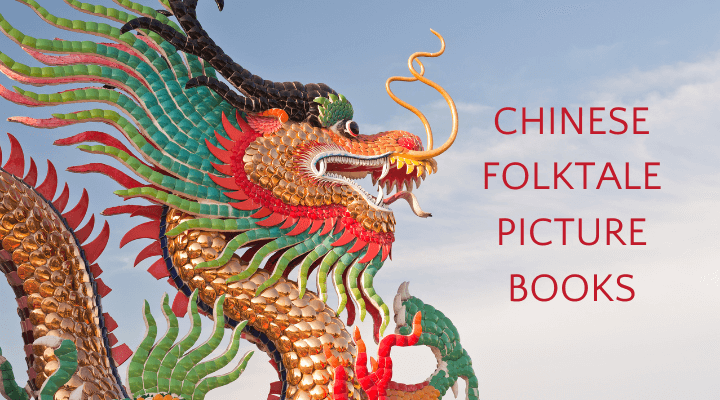
Note: this list contains affiliate links. Purchases made through these links may earn commission.

Nine Color Deer by Kailin Duan. Duan adapted a traditional Buddhist tale for her gorgeously illustrated picture book. In a forest in the mythological Kunlun Hills of China lives a white deer adorned with multicolored patches on its hide. The Nine Color Deer is revered as a guardian spirit but when its act of kindness is betrayed, the deer reveals humankind's greed and arrogance. There's a moral to the story, but it is not heavy handed and the illustrations are a complete joy.
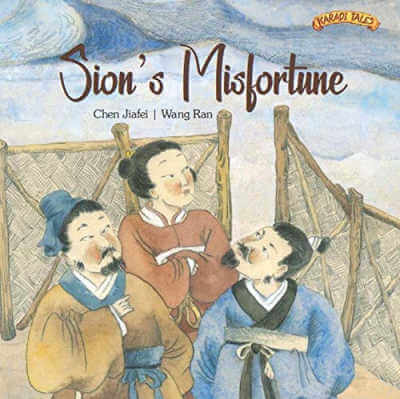
Sion's Misfortune by Chen Jiafei, illustrated by Wang Ran. One of the things I loved best about this story is how the title character looks at his circumstances from different perspectives. Sion is a fortune teller, but when things start to go wrong for him, he tells others that the situation may not be bad luck, after all. It's a great book to get your talking with kids about how to reserve judgement and to look at events from all angles. It's also great fun to read aloud.
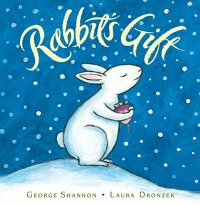
Rabbit's Gift by George Shannon, illustrated by Laura Dronzek. This is a gentle folktale about showing kindness towards others. Rabbit finds a turnip in the snow, but as he is eating it, he thinks of his friend, Donkey, and wonders if she has any food. Rabbit leaves her extra turnip at Donkey's door and when Donkey finds it, she leaves it for her neighbor, Goat. On and on it goes, with each friend, in turn, considering the well being of another. Eventually, they all come together for a meal in friendship. A wonderful story.
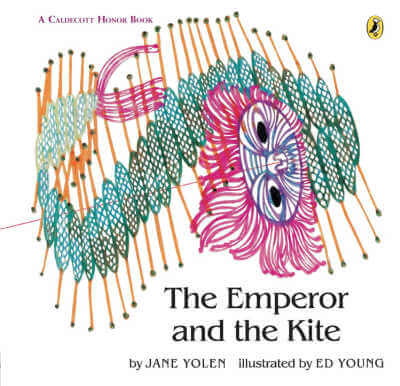
The Emperor and the Kite by Jane Yolen, illustrated by Ed Young. Princess Djeow is so small that she goes unnoticed by her family. Her favorite toy is a kite that she flies every day, "like a flower in the sky." When her father is captured and imprisoned in a tower, her siblings become useless, spending their days weeping and moaning. Djeow, however, uses her kite to fly baskets of food to her father. One day a passing monk gives her inspiration in the form of a poem and the intrepid princess invents a way to use her kite to rescue her father. He realizes his daughter's worth and she rules alongside him.

The Seven Chinese Sisters by Kathy Tucker, illustrated by Grace Lin. This is a fun version of the Seven Chinese Brothers (see below) and I'm happy that I was able to find a book illustrated by Grace Lin to include on this list. Each of the sisters has a special talent and my kids got a big kick out of their "modern skills," such as being able to ride a scooter as fast as the wind, or catch any ball. My math-loving older son thought it was hilarious that one sister could "count to five hundred and beyond." (He informed me he could do much better than that!) When the baby sister is captured by the hungry dragon, the other six use their superpowers to save her.
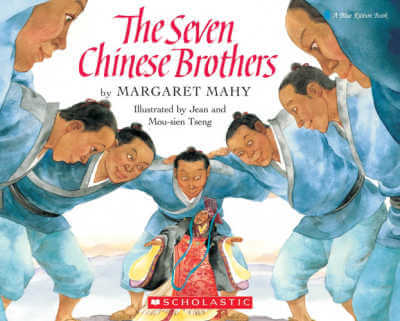
The Seven Chinese Brothers by Margaret Mahy, illustrated by Jean Tseng and Mou-sien Tseng. This is the "original" (obviously all folktales are versions of oral tales, so whose to say it's the original-original) version of the above story and a good one to read if your kids are into superheroes. All of the brothers have a super-power of sorts. One has bones of steel, another has superior eyesight, yet another has marvelous hearing... etc. I love how the baby brother's "power" is that he can cry so many tears he is able to wash away an entire village. (Don't we know that to be true, fellow parents!) The cruel Emperor Chi'in Shih Huang attempts to destroy the brothers, but their superhuman strengths bring them through with aplomb.

King Pom and the Fox by Jessica Souhami is a version of the Puss-in-Boots story. Li Ming loves his pomegranate tree (hence the moniker, "King Pom"). When he snares the fox who has been stealing the precious fruit, the fox offers to make Li Ming a rich man. Through a series of tricks, the fox convinces everyone that Li Ming is a real king and wins him the hand of the Emperor's daughter. A fun read aloud.
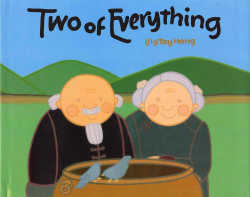
Two of Everything by Lily Toy Hong. My then-5 year old thought this folk story about a couple who have a barrel that duplicates whatever falls into it was hilarious. A man finds a large pot in his garden. When he uses it to store his purse of gold coins, he discovers the pot's magic properties. The couple use the pot to increase their wealth and double everything they own, including themselves. I liked that this book had no didactic moral about greed and that the couple didn't automatically get corrupted by their new wealth. It's a fun Chinese folktale to read aloud.
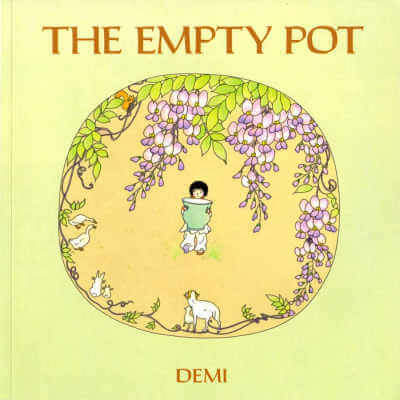
The Empty Pot by Demi. Ping loves to garden, and grows the most beautiful plants and flowers. An aging emperor with no heirs proclaims that the child who grows the most wonderful flower will succeed him. He gives every child a seed, but Ping is distressed because even after a year, his seed has not sprouted. He takes his empty pot to the emperor, who reveals the truth behind the barren pot.
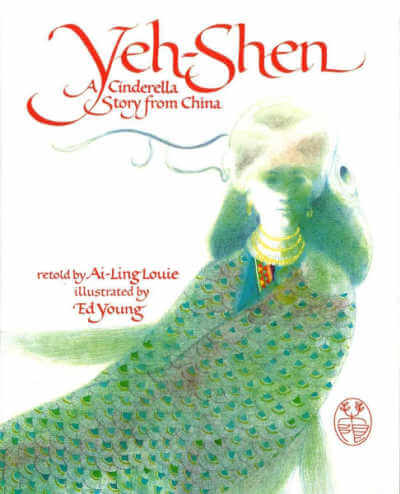
Yeh-Shen: A Cinderella Story from China by Ai-Ling Louie, illustrated by Ed Young. Cinderella stories are immensely popular and many cultures have their own versions. This one is reputed to be the oldest, predating the Western version by at least 1000 years, so it's worth a read. A fish replaces the godmother, but most of the other elements are here–the jealous stepmother and sisters, the ball, the shoes, the hunt for the mysterious girl, and the punishment of the mother and sisters. The biggest difference is that Yeh-Shen's kindness to the fish gives a depth to the story.
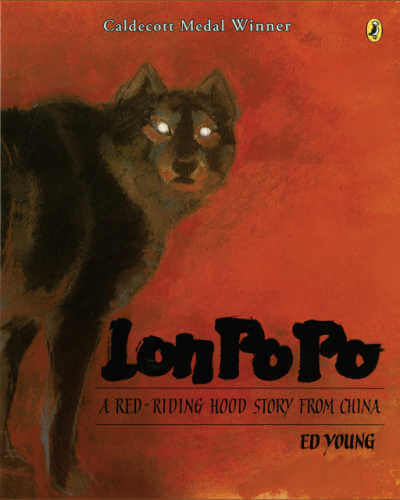
Lon Po Po: A Red-Riding Hood Story from China by Ed Young. A mother leaves her three children at home when she goes to visit their grandmother. As soon as she leaves, the wolf arrives, claiming to be the grandmother. The oldest child sees through the deception and with her siblings, climbs into the gingko tree where they trick the wolf into being captured. Although this is a story of danger with a rather menacing wolf, the children are the empowered characters here. Young's gorgeous and atmospheric paneled illustrations–modeled on a Chinese illustrative style–earned him the 1990 Caldecott.

The Water Dragon: A Chinese Legend by Li Jian includes text in both English and Chinese. One day, while collecting wood, Ah Bao finds a red stone. He drops the stone in his rice pot and the rice overflows the pot. The stone has the same effect on his money jar. When he attempts to use the stone to replicate water during a drought, he finds that the stone absorbs water and so he goes in search of the Water Dragon. Along the way he meets helpful animals who offer him advice and gifts. That's all I'm going to say because I don't want to give away the ending. It was completely different than what I expected! (In a good way.)
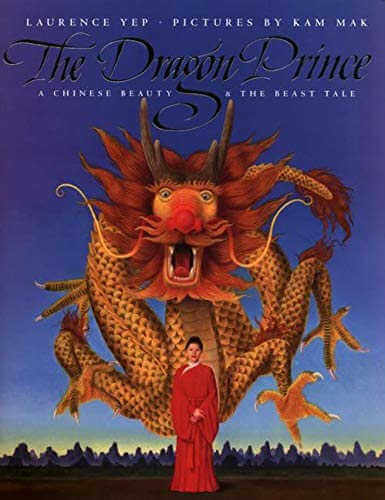
The Dragon Prince: A Chinese Beauty & the Beast Tale by Laurence Yep, illustrated by Kam Mak. I was delighted to discover this Chinese version of the fairy tale, Beauty and the Beast. There is a lot of text, but the stunning and vibrant illustrations offer ample visual interest to lap sitters during read aloud time. A poor farmer has seven daughters and when a dragon threatens to eat the farmer unless one of his daughters marries him, the youngest volunteers for the task. She is able to look past the dragon's appearance and the dragon transforms into a prince. When Seven (all the daughters are named after their birth order) returns home, one of her sisters betrays her, but the Dragon Prince sees through the deception.
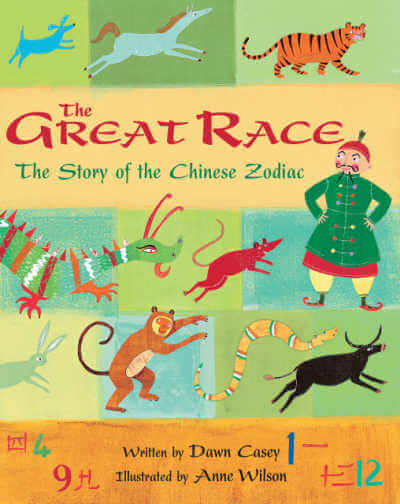
The Great Race: The Story of the Chinese Zodiac by Dawn Casey, illustrated by Anne Wilson. Have your kids ever asked why there is no "year of the cat?" This is the story that tells how each animal was chosen and given an order in the Chinese calendar. The Jade Emperor holds a swimming race across a wide river. The rat who is a poor swimmer but quite wily, concocts a plan to travel on the back of an ox but when he sees that the cat may beat him to the finish, he pushes him into the water. The rat does win in the end and is rewarded with the first year of the calendar. He never receives any punishment for his cruelty to the cat, but I suppose that's life.
MORE: Chinese New Year Books for Kids
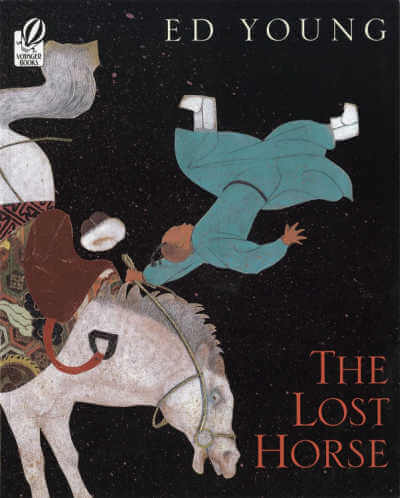
The Lost Horse: A Chinese Folktale by Ed Young. This Chinese folktale brings to life the proverbial saying, "a loss may be a gain." When a wise man, Sai, loses his horse, his neighbors advise him that it might not be a bad thing, after all. When the horse returns, he has a mate, so it seems it wasn't a bad thing. Then the new horse throws Sai's son and the cycle of loss-gain-loss-gain continues through the story. The overarching message is that life is full of many paths and changing fortunes.
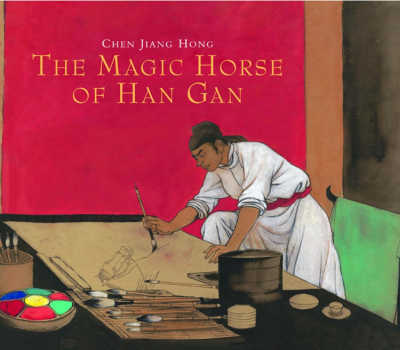
The Magic Horse of Han Gan by Chen Juan Hong is a fictionalized account of an historic figure, Han Gan, who lived in China 1200 years ago. As a young boy living in poverty, his artistic talent was discovered by a great artist and he was taken on as an apprentice. His favorite subject was the horse but he always painted them tethered. When asked why he did so, he responded they are so life-like they would leap from the pages otherwise. Indeed, that is exactly what happens and the steed becomes the horse of a mighty warrior and lives through many battles until he is finally returned to the painting. My 5 year old was fascinated with the idea that a painting could come to life. As I was reading it, I was worried he might find the battle scenes too scary. The eyes of both warrior and horse are round with terror and might. They didn't bother him, however -- a testament to the how well crafted the story is.
MORE FOLKTALES FROM AROUND THE WORLD:
African folktales
Indian folktales
Native American folktales
Celtic folktales
Latin American folktales



Jen Robinson says
My daughter is currently obsessed with Tikki Tikki Tembo!
Erica MomandKiddo says
Saying the whole name over and over *is* so much fun.
Jeanette Nyberg says
I'm actually surprised that I know a lot of these stories- I guess it's time to expose my kids to them. Cool!
Alex Baugh says
Nice choices. I'm glad to see more and more Chinese folktales. When my Kiddo was young there just weren't that many (ironically she is teaching Chinese culture now)
Erica MomandKiddo says
The only one I knew about before I started looking was Tikki (of course) but I was glad to find so many of them. There were others that I didn't put on the list, mostly because there were really text heavy and I'm just not naturally drawn to that kind of picture book.
maryanne @ mama smiles says
The Empty Pot is one of my all-time favorite children's books. I think I need to get a copy for our personal library - such an excellent story! Looking forward to reading several of these that we haven't discovered yet - thanks for the list!
Erica MomandKiddo says
I'd never read it before but it has such a wonderful simple message about the importance of truth.
Even in Australia says
Brush of the Gods by Lenore Look is another book about a Chinese painting and paintings that come to life. We love The Seven Chinese Sisters. Grace Lin also has a book, The Red Thread, which is a Chinese folktale about adoption. I need to check out Rabbit's Gift and The Emperor and the Kite, as well as a few others.
Erica MomandKiddo says
Thank you! I wonder how I missed Lin's book The Red Thread? I'll have to get that one.
Natalie says
Great list, Erika. I will be linking to it in my upcoming post on China. We read many of these books - like you, I find the moral very different in Chinese tales than in many Western stories. We also read many other Demi's books after finding An Empty Pot several years ago and enjoyed most of them.
Anna Geiger says
Wow, what a big list! Definitely some new ones for us to find here. We love The Empty Pot - it was given to our kids after a semester in Hong Kong. I like the version of The Five Chinese Brothers by Clare Huchet Bishop - a definite favorite of my childhood and one my kids love today. Then in graduate school I was taught that this book promotes ethnic stereotypes and shouldn't be used in classrooms... the pictures of the yellow skin and slanted eyes, I guess. But I still love it!
Erica MomandKiddo says
I know I read that as a kid, but honestly I don't remember it much. I also read the critical reviews of it, so I just decided since I had at least 15 other awesome books I would leave it off the list. The Seven Chinese Brothers is essentially the same story.
Crystal McClean says
These are all new ones to me, I'll be looking out for them! Thanks for linking up to Mom's Library, I'll be featuring you this week at Crystal's Tiny Treasures. Happy New Year!
Emma “My Little 3 and Me” Smith says
A great book list, thank you.
boundandgaggedbooks says
I remember Yeh-Shen! Some group came to my elementary school to perform it for us.
Erica MomandKiddo says
It would make a great show!
Roberta says
Just found this list through the kidlit book hop. What a great way to get ready for the Chinese New year coming up next week. Off to pin you to my Pinterest board...
Julie Grasso says
I think I know Tikki Tikki Tembo, but what a fabulous line up you have gathered. Thanks so much for joining us on the Kid Lit blog Hop
Jill says
This is a great collection of folktales to teach cultural diversity while inspiring imagination.
Thank you for stopping by the Thoughtful Spot Weekly Blog Hop this week. We hope to see you drop by our neck of the woods next week!
Renee @ Mother Daughter Book Reviews says
This is so perfect with Chinese New Year just around the corner. So glad you shared your recommendations in the Kid Lit Blog Hop. Pinning!!!
Veena says
Does "The Magic Paintbrush by Julia Donaldson" qualify? There is one another (published in 1938) The 5 Chinese brothers (The seven brother does sound similar, but the stories are different) and Yum Yum Dim Sum ( board book)
I am glad to find so many more books to explore come Feburary! Thank you so much!
Erica MomandKiddo says
I've never read The Magic Painbrush! Thanks for the recommendations!
Books4Learning says
Thanks for this wonderful list. There are several here I am unfamiliar with. I plan to check them out.
Annette Bay Pimentel says
It's not a folktale, but Grace Lin's Ugly Vegetables would be a nice companion book to these--putting the folktales in the context of real lived life.
Scarlet says
Thanks for this list. I want to celebrate Chinese New Year in a fun way with my kiddos but there is not much going on here in Nashville that I know about so reading these Chinese folktales will be a perfect way to celebrate and interest them in the culture.